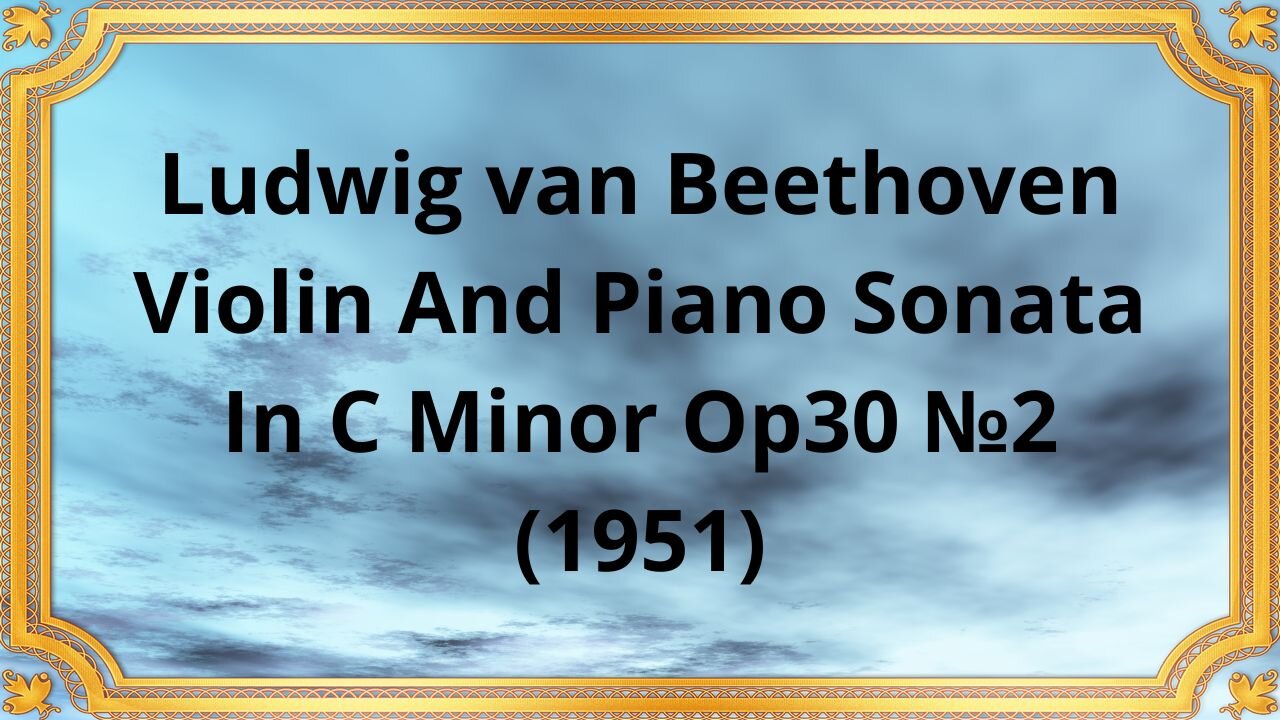Premium Only Content

Ludwig van Beethoven Violin And Piano Sonata In C Minor Op30 №2 (1951)
#Beethoven #ViolinandPianoSonata #CMinor #Op30No2 #ClassicalMusic #MusicalComposition #MusicHistory #Composer #PianoMusic #ViolinMusic
Publication date 1951
Walter Schneiderhan; Heinrich Berg
Ludwig van Beethoven, one of the greatest composers in history, left an indelible mark on the world of classical music. His Violin and Piano Sonata in C Minor, Op. 30 No. 2, often referred to as the "Storm" Sonata, showcases Beethoven's unparalleled ability to evoke intense emotions through music.
Composed between 1801 and 1802, during Beethoven's middle period of artistic development, the Violin and Piano Sonata in C Minor, Op. 30 No. 2, stands as a testament to the composer's musical genius. This period was marked by Beethoven's transition from the classical style of Mozart and Haydn to his own unique and revolutionary approach.
The sonata follows the traditional three-movement structure, consisting of Allegro con brio (fast and lively), Adagio cantabile (slow and lyrical), and Scherzo: Allegro (fast-paced). Each movement displays distinct characteristics that contribute to the overall impact of the piece.
The Violin and Piano Sonata in C Minor, Op. 30 No. 2, is renowned for its dramatic and intense nature. Beethoven masterfully employs dynamic contrasts, sudden shifts in tempo, and bold harmonic choices to create a sense of tension and release. The opening movement, Allegro con brio, captivates listeners with its powerful and stormy atmosphere, earning the sonata its nickname.
Both the violin and piano parts require exceptional technical skill and virtuosity. The violin carries melodic lines that soar above the piano accompaniment, engaging in a dialogue of musical expression. Beethoven's demands on the performers' technical abilities elevate the sonata to a challenging and rewarding piece for musicians and audiences alike.
The Violin and Piano Sonata in C Minor, Op. 30 No. 2, represents a pivotal moment in Beethoven's compositional journey. Its innovative approach to form, emotional depth, and technical complexity have influenced countless composers and performers throughout history. The sonata serves as a testament to Beethoven's enduring impact on the evolution of classical music.
Ludwig van Beethoven's Violin and Piano Sonata in C Minor, Op. 30 No. 2, remains an iconic masterpiece in the realm of classical music. Its ability to evoke powerful emotions, its technical complexity, and its lasting influence on subsequent generations of composers and musicians make it a cherished and celebrated work. Through this sonata, Beethoven's indomitable spirit and artistic vision continue to resonate with audiences, reminding us of the transformative power of music.
You have the opportunity to support the channel:
https://destream.net/live/RadSiarAl/donate
https://www.buymeacoffee.com/6355radsiaral
-
 2:05:07
2:05:07
Darkhorse Podcast
22 hours agoWhy Trump Wants Greenland: The 257th Evolutionary Lens with Bret Weinstein and Heather Heying
265K426 -
 8:50:58
8:50:58
Right Side Broadcasting Network
22 hours ago🎅 LIVE: Tracking Santa on Christmas Eve 2024 NORAD Santa Tracker 🎅
289K39 -
 2:48
2:48
Steven Crowder
1 day agoCROWDER CLASSICS: What’s This? | Nightmare Before Kwanzaa (Nightmare Before Christmas Parody)
279K12 -
 33:49
33:49
Quite Frankly
22 hours agoThe Christmas Eve Midnight Telethon
83.6K16 -
 2:12:46
2:12:46
Price of Reason
21 hours agoAmber Heard BACKS Blake Lively Lawsuit Against Justin Baldoni! Is Disney CEO Bob Iger in TROUBLE?
44.6K13 -
 1:01:17
1:01:17
The StoneZONE with Roger Stone
16 hours agoChristmas Edition: Why the Panama Canal is Part of the America First Agenda | The StoneZONE
122K46 -
 18:12:15
18:12:15
LFA TV
1 day agoLFA TV CHRISTMAS EVE REPLAY
133K15 -
 13:32
13:32
Scammer Payback
17 hours agoChanging the Scammer's Desktop Background to his Location
6.35K3 -
 4:21
4:21
BIG NEM
19 hours agoNikola Tesla's Secret to Cultivating Creativity & Genius
6.52K1 -
 15:03
15:03
The Anthony Rogers Show
1 day agoAnthony Rogers - Live at Cusumano's Pizza (Upstairs)
3.26K1